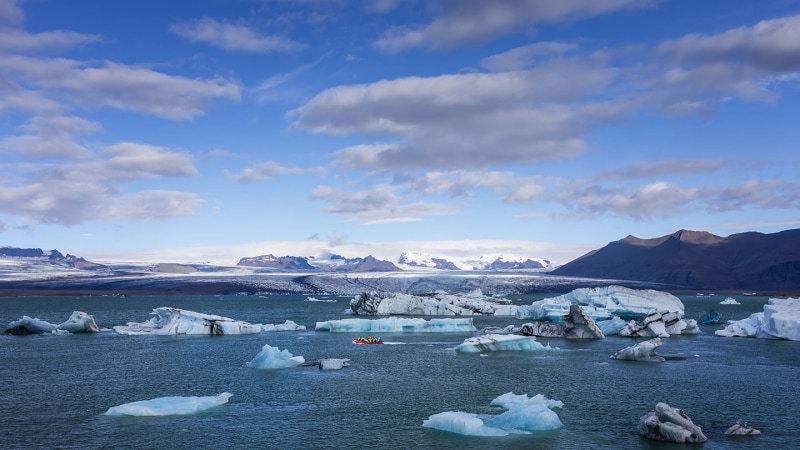Guide to cruising to Iceland

Quick insights
- Many Iceland cruises start and end in the capital of Reykjavik.
- You will need a valid passport to cruise to Iceland.
- Booking a cruise 6-12 months in advance of your trip may provide better options for accommodation and excursions.
Iceland is called the Land of Fire and Ice. In this small island country, you can find black sand beaches, volcanoes, glaciers and a wild, natural beauty that is synonymous with its nickname.
With more than 3,000 miles of coastlines that include breathtaking fjords and steep hillsides that meet the sea, Iceland offers a variety of things to do and see when you take a cruise. Read on to learn more about planning and preparing for an Iceland cruise.
An intro to cruising to Iceland
There are many reasons to consider cruising to Iceland. The natural beauty that features geysers, glaciers and occasionally the Northern Lights is unlike most other places on Earth. From your ship, you may also get to see wildlife including whales, puffins and seals frolicking in their natural habitats.
If it’s history and culture you’re after, you can explore everything from Viking history to modern Icelandic music and cuisine.
The best time to cruise to Iceland
The best time to cruise to Iceland is typically during the summer months, from June to August. This is when the weather is most favorable, and daylight hours are longest. But don’t associate Iceland’s high temps with beach weather. Highs from June to August average in the mid to upper 50s.
You may also consider cruising in May and September—what is called the shoulder season. These months are slightly cooler with an average high in the mid to high 40s, but you’ll likely avoid the biggest tourist crowds.
If seeing the Northern Lights is a top priority, you’ll want to try to time your cruise for either late autumn or early spring. That’s when you’ll have the best chance of seeing the skies light up over Iceland.
How far in advance to book an Icelandic cruise
Iceland is a popular cruise destination. Because of that, you will likely want to book your cruise at least 6-12 months in advance, particularly if you plan to cruise during peak travel times. Booking early can help not only secure your space on the ship but may also offer a better choice of accommodations and excursions.
Itinerary for a cruise to Iceland
Many cruises to Iceland offer a 7-day itinerary that circles this island nation. Cruise routes typically include stops in Reykjavik, Akureyri, Isafjordur, and Seydisfjordur. You can also find longer 14-day cruises, some of which include stops in Greenland or Scotland.
Iceland is known for its rugged natural beauty so day trips can include dipping in a geothermal hot spring, strolling through quaint towns or standing under 300-foot waterfalls. Popular excursions in Iceland include:
- Visiting the Blue Lagoon in Reykjavik
- Whale watching in Akureyri
- Exploring the fjords in Isafjordur
- Hiking in Seydisfjordur
Land excursions will likely require additional transport to reach some of Iceland’s most iconic sites. You can often book excursions directly through the cruise line or through a separate travel guide or company.
While on the ship, you may have opportunities to immerse yourself in Icelandic culture and cuisine as well. In addition to typical ship activities—which often include spa services and onboard entertainment— your cruise may offer may offer enrichment activities meant to inform about the history and culture of Iceland.
Preparing for your cruise to Iceland
When preparing to go to on an Iceland cruise, it can be helpful to think through what documents you need to bring and what to pack:
Essential documents
You will need a valid passport to cruise in Iceland. It ideally should be valid for at least six months after your cruise ends and have at least two blank pages for entry stamps. Visas are typically not required for stays less than 90 days. You may want to check with the cruise line you're traveling with for more specific documentation information.
Packing
Iceland is a prime destination for nature lovers, so packing will likely involve rugged outdoor gear, rather than your Sunday best. Layering will allow you to adjust your clothing to fit the weather, which can change rapidly throughout the day.
Rain is possible any time of year. Waterproof jackets and pants will help keep you warm and dry while navigating rugged Icelandic landscapes, which can include everything from volcanoes to waterfalls. A good pair of waterproof hiking boots will likely come in handy as well. If seeing wildlife is top on your list of experiences, a good pair of binoculars might be a must-have item in your suitcase.
What to know before cruising to Iceland
When it comes to being on the ship, here are a few other things you may want to know:
- Speaking English: English is widely spoken in Iceland. Even though Icelandic is the official language, many native Icelanders speak English.
- Health: Seasickness is a common issue on cruises. If you’re prone to motion sickness, consider bringing over-the-counter medication, motion sickness wristbands or ginger capsules.
- Tipping: Most cruise lines add a daily service charge or gratuity to the price of the trip. Many services aboard a ship like spa and bar service have a gratuity that may be automatically added to your bill.
- Wi-Fi: Wi-Fi likely will be an additional charge. Most cruise lines charge a daily fee for access to Wi-Fi. Also, keep in mind that cruise ship internet might not be as fast and reliable as your home internet connection.
Before traveling to any foreign country, it may be wise to check with the U.S. State Department. It can sometimes issue travel advisories for increased caution in certain areas.
In summary
Iceland is a rich island nation is home to breathtaking natural wonders and wildlife like whales and puffins. Cruising to Iceland can be a great way to experience the culture, food and history both on board the ship, from its deck and while exploring some of its major cities and majestic coastlines.



